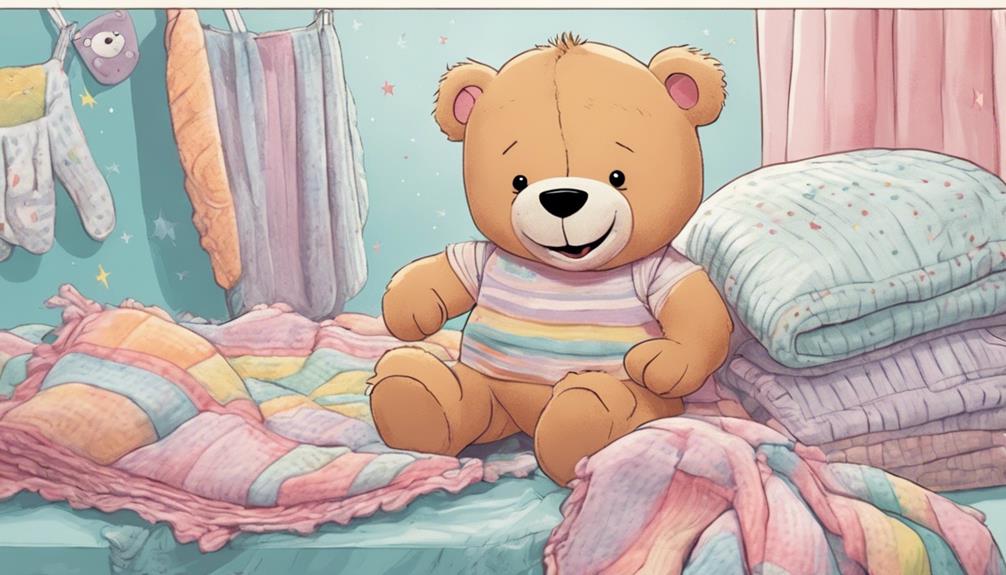Teething usually starts around 6 months, and that's when your baby's first teeth begin to come in. Typically, the lower central incisors are the first to emerge, followed by the upper central incisors a few weeks later. You might notice increased drooling, tender gums, and some fussiness during this time. It's important to provide comfort through gentle gum massage or chilled teething rings. All 20 primary teeth should appear by age 3. Understanding the teething process can help you manage any discomfort your little one experiences, and there's more to discover about soothing methods and dental hygiene practices ahead.
Key Takeaways
- Teething typically begins around 6 months, but some babies may start as early as 3 months or as late as 12 months.
- The first tooth usually erupts as the lower central incisor between 6-12 months of age.
- Following the lower central incisors, upper central incisors appear about 4-8 weeks later, around 8-12 months.
- All 20 primary teeth should be present by age 3, with four teeth typically emerging every six months.
Teething Timeline

Teething usually kicks off around 6 months, but some babies might start as early as 3 months or as late as 12 months.
When babies start teething, you'll likely notice signs like drooling, fussiness, or a desire to chew on objects. The first tooth to erupt is typically the lower central incisor, appearing between 6-12 months. After this, the upper central incisors generally follow about 4-8 weeks later, usually around 8-12 months.
As you chart your baby's progress, keep an eye on the tooth eruption chart, which outlines the general timeline for primary teeth. After the central incisors come the lateral incisors and first molars, with four teeth typically emerging every six months. By the time your child turns 3, they should have all 20 primary teeth.
This teething timeline can vary, so don't worry if your baby's teeth begin to erupt a bit earlier or later than the averages.
Just remember, each tooth marks a new milestone in your little one's development, and patience is key as they navigate this natural process.
Importance of Fluoride

Fluoride plays an essential role in preventing dental decay as your baby's teeth come in.
You'll want to guarantee your child gets enough fluoride, whether through tap water or dental treatments recommended by their pediatrician.
Understanding safe water sources and proper fluoride use can set your little one up for a healthier smile.
Fluoride's Role in Prevention
As your baby's teeth begin to emerge, ensuring they get enough fluoride is essential for strengthening their enamel and preventing dental decay. Fluoride plays a vital role in maintaining your child's oral health, helping to protect against cavities. Pediatricians recommend that once teeth emerge, you consider fluoride varnish applications to provide an extra layer of protection.
Here's a quick reference table to understand fluoride sources and their benefits:
| Fluoride Source | Benefits | Recommendation |
|---|---|---|
| Municipal Tap Water | Contains added fluoride | Check if it's fluoridated |
| Bottled Water | Often lacks fluoride | Read labels carefully |
| Fluoride Varnish | Strengthens enamel, prevents cavities | Apply after teeth emerge |
| Fluoride Toothpaste | Helps remineralize teeth | Use a small amount for brushing |
Safe Water Sources
Accessing safe water sources is fundamental for your baby's dental health, especially since many municipal supplies are fluoridated to help strengthen their teeth.
Fluoride plays a significant role in preventing tooth decay, making it an important component of your baby's diet. When you introduce water to your little one, consider using municipal tap water, as it typically contains the fluoride your baby needs for strong teeth.
Starting around six months, you can offer water through a sippy or straw cup. This not only helps your baby get used to drinking but also guarantees they receive the benefits of fluoride. However, keep in mind that most bottled water lacks fluoride, so relying solely on it may not provide the same dental advantages.
If you're uncertain about your baby's fluoride intake, consult with a pediatrician. They can provide guidance on whether additional fluoride supplements are necessary based on your child's specific needs.
Pediatrician Guidance on Fluoride
Pediatricians emphasize the importance of fluoride for strengthening your baby's teeth and preventing cavities from an early age. Fluoride plays a key role in early dental care, especially for infants who are teething. When your baby's first teeth emerge, it's essential to guarantee they receive adequate fluoride, as it helps protect against decay.
Many pediatricians recommend introducing fluoridated tap water in a sippy or straw cup around six months. This can help meet your child's fluoride needs. However, be cautious with bottled water, as most brands lack fluoride. Always check the labels to confirm your baby gets the necessary fluoride for peak dental health.
Once your child's teeth appear, your pediatrician might suggest applying fluoride varnish. This treatment greatly reduces the risk of cavities in young children and is an important step in your child's dental care routine. Consulting your pediatrician will help you determine the best fluoride approach for your infant, especially if fluoridated water isn't part of their diet.
Prioritize fluoride to give your baby a strong foundation for healthy teeth!
Soothing Teething Pain

When your baby starts teething, you'll want to explore effective pain relief methods to ease their discomfort.
Safe teething aids can make a big difference, but it's essential to consult your pediatrician for guidance.
Understanding the right approach will help you keep your little one comfortable during this challenging time.
Effective Pain Relief Methods
Gently massaging your baby's gums with a clean finger can offer immediate comfort during the teething process. By applying gentle pressure, you can help soothe your little one's sore gums, making them feel more at ease.
Here are some effective methods to relieve teething pain:
| Method | Description | Safety Tips |
|---|---|---|
| Chilled Teething Rings | These rings can be chilled for numbing relief. | Verify they're made of safe materials. |
| Frozen Washcloths | A clean, damp washcloth can be frozen for soothing. | Supervise your baby at all times. |
| Teething Biscuits | Crunchy biscuits can help ease teething symptoms. | Monitor to prevent choking hazards. |
If your baby seems particularly distressed, over-the-counter options like acetaminophen or ibuprofen may be considered. However, always consult with a healthcare provider before administering any medication to verify it's safe and properly dosed. Remember that while teething can cause discomfort, it's a natural process that every baby goes through.
Safe Teething Aids
Many parents often seek safe teething aids to help soothe their baby's discomfort during this challenging phase. Solid rubber teethers and chilled teething rings are excellent options, providing relief without posing choking hazards.
Cold washcloths, when frozen, also work effectively to ease sore gums. Just give your little one a clean washcloth, freeze it, and let them gnaw on it for a soothing experience.
When choosing teething toys, always verify they're BPA-free and free from small parts that could become choking risks.
Gentle gum massage with a clean finger can also be a simple yet effective way to alleviate teething pain without relying on commercial products.
It's vital to avoid teething gels containing benzocaine, as these can lead to serious side effects in infants under two years old.
Instead, focus on natural and safe options to help your baby through this tough time. With the right teething aids, you can provide comfort and relief, making the teething process a little easier for both you and your baby.
Pediatrician Consultation Importance
Consulting a pediatrician helps you understand the best pain relief options for your teething baby, guaranteeing their comfort and safety during this challenging time. Your pediatrician can recommend safe medications like acetaminophen or ibuprofen if needed. They'll also suggest effective home remedies, such as massaging your baby's gums or using cold items like teething rings to soothe discomfort.
Early consultation is vital for monitoring any unusual symptoms that may arise during teething. This helps distinguish between normal teething pain and potential illnesses, giving you peace of mind. Your pediatrician can also educate you about safe teething products, steering you away from items that pose choking or strangulation risks, like amber teething necklaces and certain gels.
Additionally, regular check-ups with your pediatrician facilitate the timely application of fluoride varnish, which protects emerging teeth from decay and promotes overall dental health.
Unsafe Teething Products

Several teething products on the market are unsafe and can pose serious health risks to your baby. It's vital to be aware of these products to protect your little one from potential harm.
Here are three particularly unsafe items to avoid:
- Teething Tablets: Many contain harmful ingredients like belladonna and benzocaine, which can lead to severe side effects such as respiratory issues and seizures.
- Amber Teething Necklaces: These necklaces are often marketed as natural pain relievers, but they pose significant risks, including strangulation and choking, with no scientific evidence to back their effectiveness.
- Liquid-Filled Teething Rings: These can break easily, creating a choking hazard if your baby bites through them.
Always consult your pediatrician before using any teething aids. They can provide guidance on safe options for alleviating teething pain.
Oral Hygiene Practices

Establishing good oral hygiene practices early on is crucial for your baby's dental health. You should begin daily cleaning of your baby's gums with a soft cloth or gauze even before those baby teeth come in. As soon as the first tooth emerges, introduce brushing with a small, soft-bristled toothbrush and a smear of fluoride toothpaste. For children under 3, this tiny amount is critical for their developing teeth.
To help you remember the key practices, here's a quick reference table:
| Age Group | Recommended Action | Notes |
|---|---|---|
| Birth – 6 months | Clean gums with a soft cloth | Establishes good habits early |
| 6 months – 3 years | Brush with a soft-bristled toothbrush | Use a smear of fluoride toothpaste |
| 3 years + | Brush with a soft-bristled toothbrush | Use a pea-sized amount of toothpaste |
| All ages | Schedule the first dental visit | By age 1 or within 6 months of the first tooth |
Avoid putting your baby to bed with a bottle to reduce the risk of tooth decay. Following these practices guarantees a healthy start for your baby's oral hygiene journey.
Pediatrician and Fluoride Varnish

Pediatricians recommend fluoride varnish as a key step in protecting your child's dental health once the first tooth comes in. This preventive care measure helps strengthen enamel and prevents decay, making it essential for your child's oral health.
Here are three reasons why fluoride varnish is important:
- Strengthens Enamel: The concentrated fluoride in varnish bonds to your child's teeth, helping to reinforce the enamel against cavities.
- Convenient Application: Pediatricians can apply fluoride varnish during regular well-child visits, ensuring your child receives important dental care without needing a separate dental appointment.
- Safe and Effective: Fluoride varnish is safe for children and provides a steady release of fluoride over time, enhancing its effectiveness in protecting against tooth decay.
First Dental Appointment

Scheduling your child's first dental appointment after their first tooth erupts is essential for ensuring a healthy smile as they grow. Typically, this visit should happen around your child's first birthday, marking the start of their journey toward good oral health. Establishing a ‘dental home' early on creates familiarity and continuity of care, making future visits easier.
During the first dental appointment, the pediatric dentist will assess your baby's first teeth and discuss teething. They may also apply fluoride varnish if teeth are present, which helps protect them from decay. This visit lays the foundation for good oral hygiene habits, setting your child up for a lifetime of healthy smiles.
Here's a quick overview of what to expect:
| What to Expect | Why It Matters | Tips for Parents |
|---|---|---|
| Assessment of oral health | Prevents future dental issues | Bring your child's favorite toy |
| Discussion about teething | Alleviates concerns | Ask about good oral hygiene practices |
| Application of fluoride varnish | Strengthens teeth | Schedule regular check-ups |
Understanding Teething Symptoms

After your child's first dental appointment, it's important to recognize the signs of teething, as these symptoms can indicate when those precious baby teeth are starting to emerge. Understanding teething symptoms can help you support your little one during this time. Here are some common signs to watch for:
- Increased Drooling: You might notice your baby drooling more than usual, which is a natural response to teething.
- Swollen and Tender Gums: As teeth push through, your baby's gums may appear red and swollen, causing discomfort.
- Irritability and Fussiness: Teething can lead to increased irritability and fussiness, disrupting your baby's usual happy demeanor.
In addition to these symptoms, you may observe a loss of appetite as your child is less interested in feeding. Some infants might also experience a mild fever, but remember, a true fever above 100.4°F typically indicates another illness.
Managing Teething Discomfort

Managing teething discomfort involves using simple techniques that can provide relief for your baby during this challenging time. You can start by gently rubbing your baby's gums with a clean finger or offering chilled items like teething rings or frozen washcloths. Solid rubber teethers are safe for chewing, while you should avoid plastic or liquid-filled teething rings due to safety concerns.
Establishing a soothing routine is essential. Incorporate gentle gum massages and safe chewable items. If discomfort escalates, monitor your child's symptoms closely. It's wise to consult a healthcare provider for the appropriate use of over-the-counter pain relief medications if needed.
Here's a helpful table summarizing various teething relief options:
| Method | Description |
|---|---|
| Teething Rings | Chilled rings to soothe gums |
| Frozen Washcloths | Provides relief when chewed |
| Rubber Teethers | Safe and durable for chewing |
| Teething Necklaces | Wearable options for parents to use |
| Over-the-Counter Relief | Consult a doctor before use |
Frequently Asked Questions
How Does a Baby Tooth Come Out?
When a baby tooth comes out, its roots dissolve as the permanent tooth pushes up from below. You'll notice it loosening over time, and eventually, a gentle tug or wiggling will help it come out.
In What Order Do Baby Teeth Come In?
When your little one starts teething, expect the lower central incisors first, followed by the upper central incisors. Then, the lateral incisors, molars, canines, and finally, the second molars will make their grand entrance!
How Long Do Babies Teeth Take to Come Through?
Teething can take several months, usually starting around 6 months. You might notice a few teeth coming through every six months, with all 20 primary teeth typically emerging by age 3, but timelines vary.
At What Age Do Baby Teeth Fall Out?
You might think baby teeth hang on forever, but they usually start falling out around age 6. By age 12, most kids have lost all their primary teeth, making way for those shiny new permanent ones!
Is the Process of Teeth Coming in for Babies the Same as Them Coming Out?
When it comes to how teeth come in for babies, the process of them coming in is actually quite different from them coming out. The process of teeth coming in for babies is called teething, and it can be a bit uncomfortable for both the baby and the parents. Teething usually starts around 6 months of age and can continue until the child is around 3 years old. It is important to monitor the process and provide relief for the baby, such as with teething toys or cold washcloths. Understanding how teeth develop in children can help parents anticipate any potential issues and provide proper care for their child’s oral health.
Conclusion
As you navigate the teething journey, think of it as a rite of passage—a small storm before the calm.
Each tooth breaking through is like a flower blooming, revealing new beauty and strength.
You've armed yourself with knowledge and tools to soothe the discomfort, guiding your little one through this phase with care.
Embrace the process, celebrate the milestones, and remember, just like every season, this too shall pass, leaving behind a dazzling smile.








